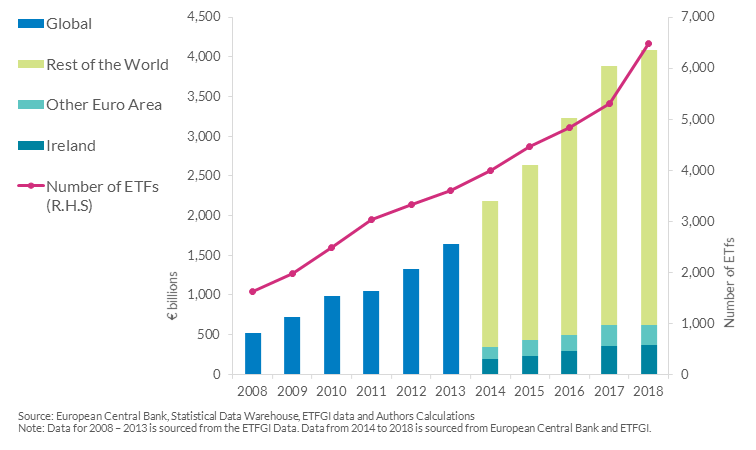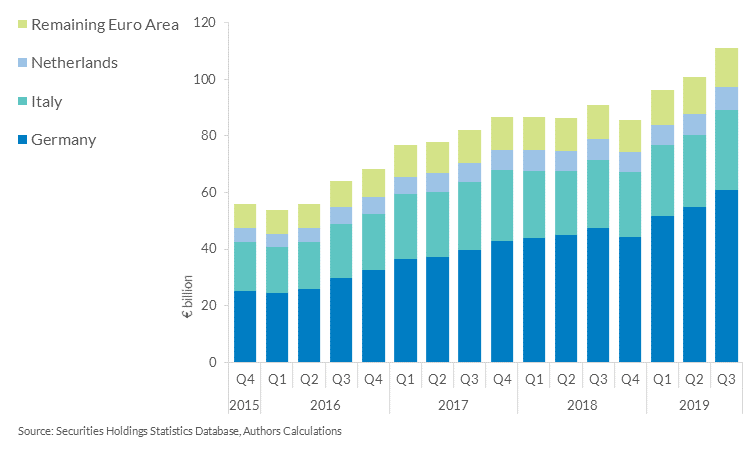Behind the Data

Exchange Traded Funds Held by Households: A Securities Holdings Perspective
Patrick Hughes and Siobhán O’Connell
January 2020
The Central Bank of Ireland publishes a wide range of data on investment funds. However, there is one fast-growing part of the sector for which there is limited information available. Exchange Traded Funds or ETFs are funds traded on stock exchanges the same way as equities. ETFs have experienced exponential growth both in Ireland and the euro area in recent years but information on the sector is lower compared to other fund categories, particularly with respect to household holdings. This “Behind the Data” piece fills that information gap and takes a closer look at the sector’s rapid rise.
A Rising Asset Class
The global ETF sector has doubled in size since 2014, with €4 trillion in assets under management at the end of 2018 (Chart 1). ETFs provide investors with a normally liquid asset that tracks a basket of securities or market index. This allows investors to easily achieve a broad exposure to a particular sector or market. International organisations are studying this market from a systemic risk perspective, with the Central Bank of Ireland also contributing to the debate.
While the ETF market is dominated by institutional investors (97% of Irish holdings are accounted for by institutional investors), low transaction costs and diversification benefits have increasingly made ETFs attractive to retail or household investors. ETFs, like other equity holdings, are not subject to protections such as the Deposit Guarantee Scheme. Additionally retail investors may not fully understand the different types of risk that arise from the relatively complex internal structures, such as potential liquidity risks that can arise from the authorised participant mechanism. An authorised participant is a party that is unique to ETF structures and that has the right to create or redeem an ETF’s shares when they spot a shortage or excess supply of ETF shares in the market.
ETFs can have different structures. Some ETFs fully replicate the returns of an underlying index, while others aim to track the returns by optimising a different portfolio with similar returns or by the use of derivatives. While ETFs may be marketed as being diversified in the sense that they provide exposure to a number of different assets, unseen concentration risk can still arise. For example, an ETF could use multiple derivatives, concentrated in a single counterparty, to replicate the returns of an index. So while investors may perceive the ETF as diversified, if this counterparty defaults, the ETF may have a difficulty receiving full payment for its position.
Chart 1: The number and assets of ETFs are growing globally

Irish Household Holdings in ETFs – Growing From a Low Base
Total Irish residents holdings (both institutions and households) of ETFs rose from €6.9 billion at end 2015 to €24 billion at September 2019. Of this, households’ holdings accounted for €329 million at end 2015, growing to €703 million by Q3 2019 (Chart 2). However while households have been consistent net purchasers of ETFs in recent years, it is valuation gains that have accounted for a greater part of the increased holding rather than new purchases of ETFs. Valuation changes in ETFs occur as a result of both price movements in the underlying assets and currency movements, as many assets are priced in non-euro currencies. ETF valuation changes have been positive in recent years, but as Chart 2 shows, these changes have been volatile.
Household holdings of ETFs are reported by custodians through the securities holdings regulation, which provides information on the sectoral holdings of all securities held by residents in the euro area. If a euro area household chooses to hold ETF securities with a non-euro area custodian, this will not be reflected within the data.
Chart 2: Irish resident households continue to purchase ETFs but valuation gains account for a large part of the increase

A Concentrated Market
Another feature of the Irish ETF market is its concentration. The top ten ETFs accounted for 49.6 per cent of the total holdings at end Q3 2019 (Table 1). The top three alone account for 24 per cent of the total ETF holdings. There is a strong preference for “equity-index ETFs”, i.e. ETFs that track equities but the top ten also includes two bond ETFs. There are only one “sector-focused” ETF contained within the top ten. Irish domiciled funds accounted for 22.1 per cent of the top ten holdings of ETFs. In terms of market or sector replication five of the ETFs replicate the market in full i.e., hold 90 per cent or more members of the index. In contrast, only two of the ETFs use derivatives such as futures or swaps to track the market or sector.
Table 1: Irish resident household holdings of ETFs are Concentrated (Q3 2019)
.png?sfvrsn=7942861d_6)
A Small Share of Household Wealth
Still, Irish households’ ETF holdings of €703 million are small when placed within the context of overall household net worth (€781 billion in Q2 2019), which in Ireland is dominated by housing wealth. Since ETFs are a relatively new investment instrument for households, growth in holdings of ETFs has not replaced households’ preference for direct holdings of quoted shares or investment funds (Irish households held €6 billion of quoted shares at end of Q3 2019). Rather ETFs provide an alternative investment option for those wishing to access a broader market or sector. A recent report from the Investment Company Institute – an industry body for regulated funds - indicated that the type of individual that holds ETFs are generally younger, have a higher education and a higher income than investors who invest in regular investment funds. All of this suggests future stronger growth.
Irish Domiciled ETFs Dominate Euro Area Household ETF Holdings
In line with global growth, holdings by euro area households of ETFs have almost doubled since end 2015 (Chart 3). In Q3 2019, euro area households held a total of €111 billion of ETF units/shares. German households accounted for 55 per cent of this total. Ireland has become a hub for ETF management, with over half of euro area household investment in ETFs (€490 billion) managed from Ireland as at September 2019.
Chart 3: German, Italian and Dutch dominate euro area Households Holdings of ETFs

Concentration across the euro area was not as pronounced as for Irish residents, with 17 percent of holdings in the top ten ETFs. However, the relative importance of a small number of ETFs in the market is still evident. Three of the top ten funds held by Irish households are in the holdings of the other euro area members. Of the top ten ETFs held by euro area households, two track the S&P 500, four track broader world market index shares, two track bond markets and two track the German DAX.
Table 2: Top 10 Preference by euro area Households for ETFs, Q3 2019 Snapshot

New Pension Data to Reveal Further Insights
While these are direct households holdings of ETFs, households may also indirectly hold ETFs throughout the euro area within their pension or investment funds. The Central Bank is in the process of collecting new asset by asset data from Irish pension funds and this will provide a look-through of the indirect household exposures to ETFs in 2020, which may be significantly larger than the direct holdings. Additionally, a new wave of the household finance and consumption survey could provide additional granular information to inform full risk assessment of household financial assets.
Overall, both Irish and euro area households show that ETF asset holdings are increasing and ETF investment is concentrated within a few ETFs, especially for Irish households.
** Email [email protected]. The views expressed in this note are those of the authors and do not necessarily reflect the views of the Central Bank of Ireland or the ESCB. Comments from Mark Cassidy, Reamonn Lydon, Rory McElligott, Aisling Menton and Maria Woods are gratefully acknowledged.
See also: